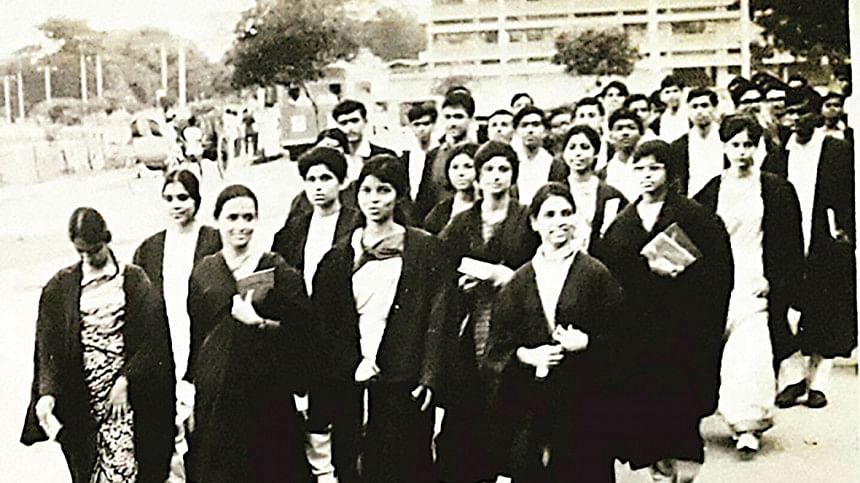Snippets From “A View from the Ladies Common Room, Dacca University”

DU. How those letters conjure up a sense of awe and bittersweet memory. Always in the vanguard of political, progressive movements… Language (1952), Constitution (1962), Democracy (1968/69) and Independence (1971)… but distinguished too, for its intellectual environment and academic excellence. Dacca University's endless graffiti marked corridors were a daunting place for me, a teenager and a female, in the politically momentous years of the late 1960s.
***
At DU we did not receive, nor did we expect any preferential treatment either from the Administration or our Professors. Apart from a few 'reserved' seats in the first few rows of lecture rooms all students were deemed democratically and biologically equal.
There was however one exception, where female autonomy and independence was guaranteed: the Ladies Common Room. Located on the ground floor of the Arts Faculty building, it was our special quarter, our Zenanah. Men had their Modhu's canteen and jointly we could fraternise at the TSC (Teacher Student Centre) but the ladies common room was our personal space.
No man could enter its portals. Not even the Dean, Vice Chancellor or the Governor himself … except the teenage boy from the canteen. Deferentially the blushing lad would enter and with lowered gaze, take our orders for Singhara, Aloor Chop, Roshogollah, and Cha.
Just two wide rooms and a central pathway buzzed with constant chatter and bonhomie. Old acquaintances were renewed and new friendships formed that still survive. It was a place where we could literally let down our hair, refresh, play table-tennis, read newspapers or take forty winks on the armchairs; a place of interaction where we exchanged ideas, gossip, confirmed or denied rumours.
***
This is where we escaped when 'Rag Day' colour festivities became too riotous or hid when the fearsome twosome 'Khoka' went walkabout with his pet snake and knife-wielding assistant 'Passpartout. ' (Aptly nicknamed as he had not passed beyond part two of any educational institution!) Suffice to say, they were not fellow students but professional goons sent by the Government to terrorise the student body. But even Khoka, snake and sidekick did not dare enter the Ladies Common Room.
***
This was the era of the Vietnam War, Russian invasion of Czechoslovakia, Paris student uprising and the Sino-Soviet split. Revolution was on the doorstep. Even the fiery Tariq Ali, came all the way from London to address us under the Bot Tala…the Banyan tree. There was hope, idealism and a feeling that the 'times-they - are - a changing,' like in the Bob Dylan song.
Surprising as it may sound, in the midst of these distractions we did manage to attend classes, tutorials, visit libraries and receive an education. But as later events testify, this was the calm before the storm. Earth-shattering, epoch-making times were just round the corner. Not just the November 1970 cyclone but a major political hurricane was brewing in the country. Twice the authorities closed the university Sine Die with no date for resumption. Hostels were emptied, students went home. It was a portend for darker days that lay ahead when DU would become the eye of the storm.
Ghazala Akbar was once the Feature Editor of the Arab Times, Kuwait. Now-a-days she lives in London. The full article was published on 14 July 2018 in the Star Literature Page.

 For all latest news, follow The Daily Star's Google News channel.
For all latest news, follow The Daily Star's Google News channel. 



Comments